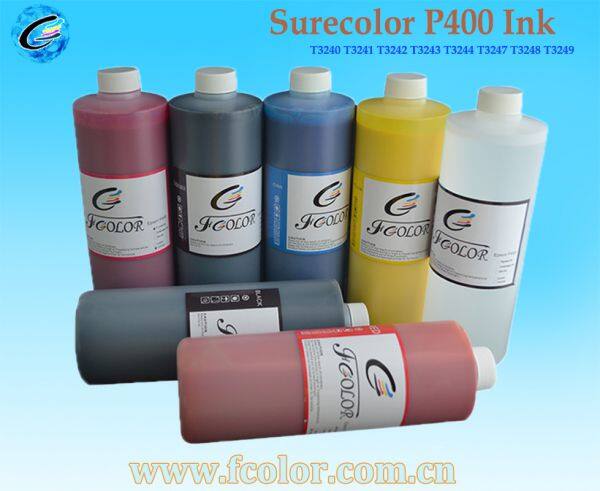Classification And Characteristics Of Inkjet Printer Ink
2020-09-17 11:31:00
Inkjet ink is a special colored colloid whose function is to record patterns on substrates such as paper or light box cloth. The three main components of ink include colorants (pigments), crosslinking materials (resins) and solvents. The ink mixture including the solvent is spray-printed on the substrate. As the solvent evaporates, the crosslinking material firmly combines the colorant (pigment) with the substrate to form a pattern.
Digital inkjet ink can be divided into water-based and solvent-based. According to the solvent, it can be divided into water-based and non-water-based inks. Water-based inks can be classified into pigment-based, dye-based, and sublimation inks according to color materials; non-water-based inks can be divided into oil-based pigment inks and solvent-based Pigment Ink. From a chemical point of view, oil is also one of the solvents. We collectively refer to them as non-water-based inks. In addition, there is a UV-curable ink that is rarely mentioned in China. The ink of Inkjet Printers can be roughly divided into these 6 types.
Advantages and disadvantages of various inkjet inksThe advantage is that the color is bright, because it is made of water, evaporates the water, and has no harm to the environment, and is more environmentally friendly; the disadvantage is that it is easy to fade and is generally only used indoors.
The advantage is good light resistance; the disadvantage is that the color is relatively dark.
The advantage is that it can be transferred to different media, not just paper. Such as ceramics and glass. Many different media can be transferred; the disadvantage is that the operating procedures are more troublesome and the price is higher.
Since the oil-soluble ink is made of pigments, it has the advantage of being odorless and good light resistance; the disadvantage is that it is expensive and must be printed on a coated medium.
Because it is pigmented, it has the advantages of good light resistance and water resistance, and it can be printed on any medium. The disadvantage is that the oil base used in this ink itself is flammable, dangerous, and has a strong smell, which is harmful to the human body.
The advantage is that the ink itself does not contain volatile solvents, and after curing, it has good light resistance and water resistance, so it is very suitable for the printing industry; the disadvantage is that some of its monomers can easily cause some people’s problems before curing. Allergic reaction.
-
Extra Black Film Plate Burning EPSON T series Ink Cartridge
-
Compatible ink cartridge T6942 T6943 T6944 for EPSON SC-T series ,Water-based dye ink
-
Compatible ink cartridge T6942 T6943 T6944 for EPSON SC-T series ,Water-based dye ink
-
Compatible ink cartridge T6942 T6943 T6944 for EPSON SC-T series ,Water-based dye ink
-
Extra Black Film Plate Burning EPSON T series Ink Cartridge
-
Extra Black Film Plate Burning EPSON T series Ink Cartridge
-
Compatible ink cartridge T6942 T6943 T6944 for EPSON SC-T series ,Water-based dye ink
-
Compatible ink cartridge T6942 T6943 T6944 for EPSON SC-T series ,Water-based dye ink
-
Compatible ink cartridge T6942 T6943 T6944 for EPSON SC-T series ,Water-based dye ink
-
Extra Black Film Plate Burning EPSON T series Ink Cartridge
-
Extra Black Film Plate Burning EPSON T series Ink Cartridge
-
Extra Black Film Plate Burning EPSON T series Ink Cartridge
-
Extra Black Film Plate Burning EPSON T series Ink Cartridge
-
Compatible ink cartridge T6942 T6943 T6944 for EPSON SC-T series ,Water-based dye ink
-
Compatible ink cartridge T6942 T6943 T6944 for EPSON SC-T series ,Water-based dye ink
-
Compatible ink cartridge T6942 T6943 T6944 for EPSON SC-T series ,Water-based dye ink
-
TK8800 TK8801 TK8802 TK8803 TK8804 TK8805 TK8806 TK8807 for Kyocera ECOSYS P8060cdnG P8060cdn Cartridge Toner Chip Replacement
-
Compatible replacement smart chip 51B5H00 for Lexmark MS417 517 617 MX417 517 617 Cartridge Toner Chip
-
Compatible replacement smart chip 51B1H00 for Lexmark MS417 517 617 MX417 517 617 Cartridge Toner Chip
-
Samsung Chip CLP-K610A CLP-C610A CLP-M610A CLP-Y610A for Samsung CLP-610 CLP-660 CLX-6200 CLX-6210 CLX-6240 Toner Cartridge
-
Cartridge Toner Chip TO5070TY for TOSHIBA C-Studio257 257s 307 307sd 307s 357 357sd 457 457sd 457s/507 Printer Cartridge Chip
-
Unit Toner Chips T-FC616UK T-FC616UC T-FC616UM T-FC616UY for Toshiba e-STUDIO 5516ACT 6516AC ACT 7516AC ACT Toner Cartridge Chip
-
Toner Chip T-FC616WWK T-FC616WWC T-FC616WWM T-FC616WWY for Toshiba e-STUDIO 5516ACT 6516AC 6515ACT 7516AC 7516ACT Cartridge chip
-
TN2424 compatible toner chip resrtter for Brother MFC-L2770DW printer cartridge reset chips

